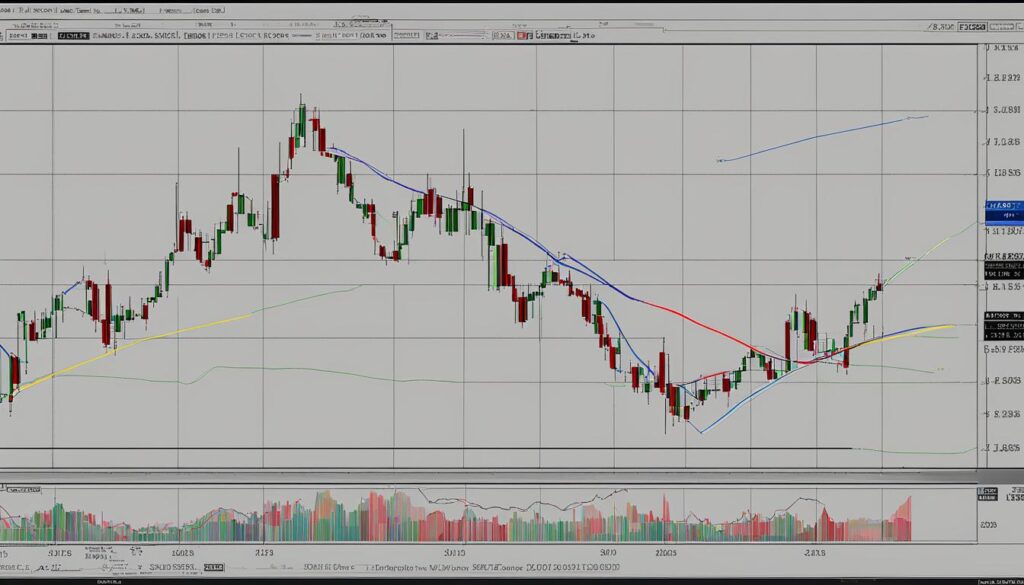Understanding the psychology behind stock market behavior is crucial for investors and traders alike. Stock market psychology explores the emotional aspects of investing and the cognitive biases that influence decision-making in the financial world. By examining investor behavior and the mindset that drives financial choices, we can gain valuable insights into the dynamics of trading and market sentiment.
Trading psychology is a branch of behavioral finance that focuses on the psychological factors that affect trading decisions. It explores how investor psychology and decision-making biases can impact market outcomes. Emotional investing, cognitive biases, and the influence of market rumors are all part of the complex world of stock market psychology.
In this article, we will delve into some startling facts about stock market psychology. We will explore the concept of overconfidence among traders, the effects of stop loss orders and round numbers on exchange rates, the role of technical analysis in trading strategies, and the impacts of big events and financial media on stock prices.
Key Takeaways:
- Investors tend to be overconfident in their abilities and often rate themselves above average.
- Emotional investing and decision-making biases can lead to costly mistakes in trading.
- Stop loss orders and round numbers have significant effects on exchange rates.
- Technical analysis can be a valuable tool, but its effectiveness varies across different markets.
- Widely talked about events and media coverage can temporarily impact stock prices.
Traders’ Overconfidence
Traders often display a tendency to overestimate their abilities and rate themselves above average. This overconfidence can have significant implications for their decision-making processes and overall trading outcomes.
One common manifestation of overconfidence is the belief in professional success beyond what is statistically probable, often referred to as the “better-than-average-effect.” Traders who fall prey to this bias may underestimate the risks they face and overstate their ability to generate profits consistently.
Trading experience plays a crucial role in minimizing the impact of overconfidence. As traders gain more experience, they become better equipped to overcome the reluctance to accept losses, a common cognitive bias known as loss aversion. By recognizing that losses are an inherent part of trading, experienced traders can develop risk management strategies that help minimize potential losses and maximize long-term profitability.
Interestingly, overconfidence is not confined to junior or inexperienced traders. Even senior traders, with years of experience and expertise, are susceptible to overestimating their abilities. This suggests that overconfidence is not simply a result of irrationality but rather a pervasive cognitive bias that affects traders at all levels.
A study focusing on currency dealers found that they tend to overestimate the precision of the information they possess and their personal competence. This overestimation can lead to misguided trading decisions and an overreliance on imperfect information.
Furthermore, overconfidence can lead traders to make irrational choices, such as being reluctant to realize losses and exhibiting a lack of diversification in their portfolios. Chinese investors, for example, have been found to make trading mistakes and display under-diversification due to overconfidence.
Even middle-aged and experienced investors struggle to overcome these behavioral biases, highlighting the pervasive nature of overconfidence in the trading community.
It is important to recognize the influence of overconfidence and actively work towards mitigating its negative effects in trading. By acknowledging the limitations of our abilities and seeking to make informed decisions based on objective market data rather than subjective self-assessments, traders can improve their overall trading performance and maximize their chances of long-term success.
The Effects of Stop Loss Orders and Round Numbers
Stop loss orders and round numbers play a significant role in shaping the dynamics of the financial markets. Understanding their impact is crucial for traders and investors looking to make informed decisions.
“Stop loss orders have a larger and longer-lasting effect on exchange rates compared to take-profit orders.”
When traders set stop loss orders, they aim to limit their potential losses by automatically closing positions if the market moves against them. These orders act as a safety net, protecting traders from significant losses. In contrast, take-profit orders are placed to secure profits when the market reaches a predetermined level.
Stop-loss orders, especially large ones, have the potential to trigger waves of selling or buying in the market. This occurs when the stop-loss orders of many traders are triggered simultaneously, amplifying the selling or buying pressure. This phenomenon is known as trend propagation.
Interestingly, round numbers have a higher reversal frequency compared to arbitrary price levels. Round numbers, such as rates ending in 00 (e.g., 1.1000), attract attention and can act as psychological barriers or key levels of support or resistance. Traders often place stop-loss orders around these round numbers, causing them to act as triggers for price movements.
In contrast, very large take-profit orders are not as likely to be clustered near round numbers, as traders typically set them based on their profit goals rather than psychological price levels.
Understanding the effects of stop loss orders and round numbers can help traders anticipate market movements and make more informed trading decisions. By leveraging these insights, traders can strategically place their orders and capitalize on the price movements driven by stop loss triggers and the psychological significance of round numbers.
| Effects of Stop Loss Orders and Round Numbers | Key Insights |
|---|---|
| 1. Larger and longer-lasting impact on exchange rates. | Stop loss orders have a significant influence on exchange rates, creating waves of buying or selling. |
| 2. Trend propagation through stop loss triggers. | Stop-loss orders, especially large ones, can trigger waves of selling or buying, amplifying market movements. |
| 3. Higher reversal frequency at round numbers. | Round numbers, such as rates ending in 00, have a higher likelihood of causing price reversals and acting as psychological barriers. |
| 4. Clustering of large stop-loss orders near round numbers. | Traders often place stop-loss orders around round numbers, leading to clusters of these orders near psychological price levels. |
What Does Research Say About Technical Analysis?
Technical analysis is a popular method used by traders to analyze historical price movements and predict future market trends. By studying charts, patterns, and various technical indicators, traders aim to make informed investment decisions. But what does research say about the effectiveness of technical analysis?
One commonly used technique in technical analysis is the use of moving averages. This tool helps smooth out price fluctuations and identify trends. When combined with investment rules, such as buying when the price crosses above the moving average, technical analysis can yield impressive results.
Adding technical analysis, such as moving averages, to investment rules can outperform other trading strategies.
Research has shown that technical analysis can lead to significant excess returns in foreign exchange markets. Traders who incorporate technical analysis techniques into their trading strategies have been able to consistently outperform the market.
However, it’s important to note that the effectiveness of technical analysis can vary across different stock indices. What works well for one market may not necessarily work for another. Market conditions, trading volumes, and other factors can impact the performance of technical analysis strategies.
Furthermore, studies have indicated that technical trading profits have shown a gradual decline over time in various futures markets. This suggests that relying solely on technical analysis may not be a foolproof strategy over the long term.
The Bottom Line
While technical analysis can provide valuable insights into market trends and help traders make informed decisions, it is not a guaranteed path to success. It should be used in conjunction with other fundamental analysis and risk management techniques to optimize investment strategies.

By understanding the limitations of technical analysis and staying updated with current market conditions, traders can develop robust and effective trading strategies. It’s important not to rely solely on technical indicators but to consider a holistic approach to investing.
Now that we have explored the effectiveness of technical analysis, let’s move on to the impacts of big events and financial media on stock prices.
The Impacts of Big Events and Financial Media
When widely talked about events occur, they often have a noticeable impact on stock prices. Following these attention-grabbing events, stock prices tend to experience a temporary rise before eventually reversing to pre-event levels. This fluctuation in stock prices can present both opportunities and challenges for traders and investors.
One interesting phenomenon that occurs during these events is net buying of stocks by active individual investors. The excitement and buzz generated by these events often lead individual investors to enter the market, resulting in increased buying activity.
However, individual investors who currently hold a company’s share may take a different approach. They tend to sell their shares as prices increase during upper price limit events. This behavior can be attributed to profit-taking or a belief that the stock has reached its peak value.
Local media coverage plays a significant role in shaping trading patterns. The presence or absence of local media coverage can greatly influence the probability and magnitude of local trading. When a particular event receives extensive coverage in the local media, it tends to generate more interest and participation from local traders.
“Local media coverage strongly influences local trading patterns, impacting the behavior of market participants.”
Furthermore, negative words in news stories related to specific firms can have predictive value. The portion of negative words in firm-specific news stories can serve as an indicator of low firm earnings. This information is particularly useful for predicting both earnings and returns.
To illustrate the impact of widely talked about events and media coverage on stock prices, consider the following example of a fictional event: the launch of a highly anticipated new product by a well-known technology company. Prior to the launch, there is a significant amount of media coverage, stirring up excitement among investors. As a result, stock prices for the company experience a surge. However, once the product is released and the initial buzz fades away, stock prices gradually revert to their pre-launch levels.
Overall, it is evident that widely talked about events and the influence of financial media can have a notable impact on stock prices and trading behavior. Traders and investors should stay informed about these events and carefully analyze media coverage to make informed decisions in the market.

Key Takeaways:
- Stock prices tend to temporarily rise following widely talked about events before reversing to pre-event levels.
- Attention-grabbing events lead to net buying of stocks by active individual investors.
- Individual investors who currently hold a company’s share tend to sell as prices increase during upper price limit events.
- Local media coverage strongly influences local trading patterns.
- The presence or absence of local media coverage is related to the probability and magnitude of local trading.
- The portion of negative words in firm-specific news stories can forecast low firm earnings and is useful for predicting both earnings and returns.
Random Findings of Trading and Investing
When it comes to trading and investing, there are several interesting patterns and behaviors that have been observed. Let’s explore some random findings that shed light on the fascinating world of finance.
Trading with Friends and News Events
Traders tend to exhibit a peculiar behavior – they often trade in parallel with their “friends” after significant news events. This suggests that social connections and shared information play a role in their decision-making process.
“Trading with friends after news events shows the influence of social networks and the tendency to follow peers in making investment choices.”
Stop-Loss Orders: Bracing for Volatility
During periods of uncertainty or high volatility, currency exchange rate dealers widen their bid-ask spreads. This adjustment aims to account for the potential risks and uncertainties associated with the volatile market conditions.
Furthermore, stop-loss orders, a popular risk management tool, can have a significant impact on trading patterns. Interdealer spreads, which measure the difference between buying and selling prices, can widen substantially after major events. However, these spreads tend to return to normal figures quickly, indicating a temporary adjustment to market conditions.
Disposition Effect: The Impact of Performance
Investors often display a behavioral bias known as the “disposition effect.” This effect is evident when investors increase the size of their trades after successful trades and decrease trade size or quit trading altogether after unsuccessful trades.
This behavior suggests that investors tend to be influenced by their past performance and that they may be more inclined to take risks or avoid further losses based on their recent trading outcomes.
“The disposition effect reflects the influence of past performance on investors’ decision-making and their propensity to take risks or avoid further losses.”
Behavior Based on Performance
Interestingly, the response of trading to performance differs based on the experience of the trader. Less experienced traders tend to exhibit a larger difference between profitable and unprofitable traders. In contrast, experienced traders may not show the same level of variation in response to performance.
Day traders, in particular, are often attracted to investments with highly skewed returns. They may also close profitable positions more frequently, suggesting a preference for short-term gains.
The Impact of Randomness
Randomness plays a significant role in trading and investing decisions. Traders’ decisions can be influenced by attention-grabbing news events, social connections, and past performance. Understanding these random findings can help traders make informed decisions and navigate the unpredictable nature of financial markets.

In the next section, we will summarize the findings and draw impactful conclusions based on the research conducted. Stay tuned for the final part of our article!
What are some surprising insights into stock market psychology?
Investors often underestimate the impact of emotions on trading decisions. According to startling stock market psychology facts, fear and greed drive many decisions. Additionally, investors tend to hold onto losing stocks for too long, hoping for a turnaround. Understanding these psychological factors can help investors make more rational decisions.
Conclusion
Awareness and self-awareness are crucial for achieving consistent profitability in trading. Traders must recognize the psychological factors that influence their decision-making, such as overconfidence and biases, in order to avoid costly mistakes. While technical analysis has yielded mixed results, understanding market history and the impact of major events and media coverage can provide valuable insights.
To navigate the volatile market conditions, traders must manage themselves effectively and maintain a mindset that combats cognitive biases. By staying informed, considering various scenarios, and staying engaged with the market, traders and investors can capitalize on opportunities and weather market storms.
In summary, being a consistently profitable trader requires awareness of the shortfalls in human psychology, market anomalies, and the negative psychological effects that can lead to costly mistakes. By consistently practicing self-awareness and implementing strategies to mitigate these effects, traders can improve their chances of success in the dynamic world of trading and investing.
FAQ
How does traders’ overconfidence affect their decision-making?
Traders tend to be overconfident in their abilities and often rate themselves above average. This overconfidence can lead to risky behavior, such as under-diversification and emotional investing. Despite experiencing losses, overconfident traders tend to remain in the market.
Are stop loss orders and round numbers significant in trading?
Yes, both stop loss orders and round numbers can have an impact on trading. Stop loss orders tend to have a larger and longer-lasting effect on exchange rates compared to take-profit orders. Additionally, round numbers have a higher reversal frequency and can trigger stop-loss orders and propagate trends.
What does research say about the effectiveness of technical analysis?
The effectiveness of technical analysis varies across different markets, but studies have shown that adding technical analysis, such as moving averages, to investment rules can outperform other trading strategies in some cases. However, the profitability of technical analysis has shown a gradual decline over time in various futures markets.
How do big events and financial media impact stock prices?
Attention-grabbing events can temporarily increase stock prices, but they tend to revert to pre-event levels. Individual investors tend to buy stocks during these events, while those who currently hold a company’s shares may sell as prices increase. Local media coverage also strongly influences local trading patterns.
Are there any random findings in trading and investing?
Yes, traders tend to trade in parallel with their “friends” after news events. Currency exchange rate dealers widen bid-ask spreads during periods of uncertainty or volatility. Interdealer spreads can widen significantly after major events but return to normal quickly. Investors also display the disposition effect, increasing trade size after successful trades and decreasing trade size or quitting trading after unsuccessful trades.
What is the importance of self-awareness in trading?
Self-awareness is crucial for becoming a consistently profitable trader. Understanding psychological factors like overconfidence and biases can help traders avoid costly mistakes. Staying informed, considering market history, and managing cognitive biases are essential in navigating volatile market conditions.

